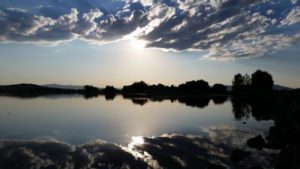Pablo National Wildlife Refuge is located off the main road in Mission Valley Montana. The refuge is wide open and kid friendly.
 First of all, the Pablo National Wildlife Refuge is 2,500 acres of water, marsh, and upland grassland. The refuge provides nesting and resting areas for migratory birds and other wildlife. Shaped by glacial activity approximately 12,000 years ago, the terrain surrounding Pablo NWR is rolling and interspersed with many pothole wetlands.
First of all, the Pablo National Wildlife Refuge is 2,500 acres of water, marsh, and upland grassland. The refuge provides nesting and resting areas for migratory birds and other wildlife. Shaped by glacial activity approximately 12,000 years ago, the terrain surrounding Pablo NWR is rolling and interspersed with many pothole wetlands.
Visitor Opportunities
Enjoy photography and wildlife observation. Waterfowl numbers vary throughout the year. There may be as many as 80,000 in October and November, and half that number in late March and through early May. A few ducks and geese may spend the winter. Nesting begins in late March and lasts through July. The most numerous nesting species are Canada geese, mallards, and redheads. Pintail, American widgeon, shoveler, blue and green-winged teal, ruddy duck, gadwall, common merganser, and coot are also present. Other species of water, marsh, and upland birds are abundant from May to October. Common loons are occasionally seen and this is a good area to see Bald Eagles.
Management Programs
There is an active Bald Eagle nest on the Refuge which regularly fledge one to two young per year. In 1996, a release of 19 trumpeter swans was conducted with the hope of re-establishing a breeding flock in the valley.
Efforts to improve wildlife habitat over the years have included planting food and cover crops for upland game birds, the construction of nesting islands for waterfowl, and prescribed burning to enhance brooding areas and provide browse for Canada geese.
The refuge is closed to hunting. The closure of Pablo NWR enhances the quality of hunting in the Flathead Valley.
Directions
Pablo National Wildlife Refuge is located approximately 75 miles north of Missoula and 3 miles south of Polson. Turn west on Reservoir Road 3 miles south of Polson. Traveling west for 1-1/2 miles will bring you to the kiosk for Pablo NWR. The dike road is open for travel during daylight hours through the summer. There are several county roads bordering the Refuge.